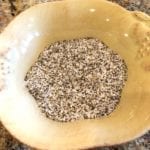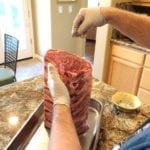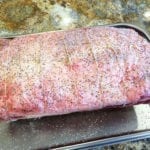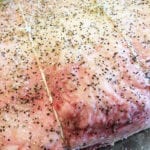Summary
- Buy a whole 7-bone standing rib roast. If necessary, remove a portion so it fits on the WSM cooking grate.
- Tie the roast at each bone.
- Season with kosher salt and pepper.
- Smoke at 225-250°F to an internal temperature of 125°F for medium rare.
- Move the roast to a preheated 500°F oven and sear exterior for 5 minutes.
- Cover loosely with foil and let rest 15 minutes before carving.
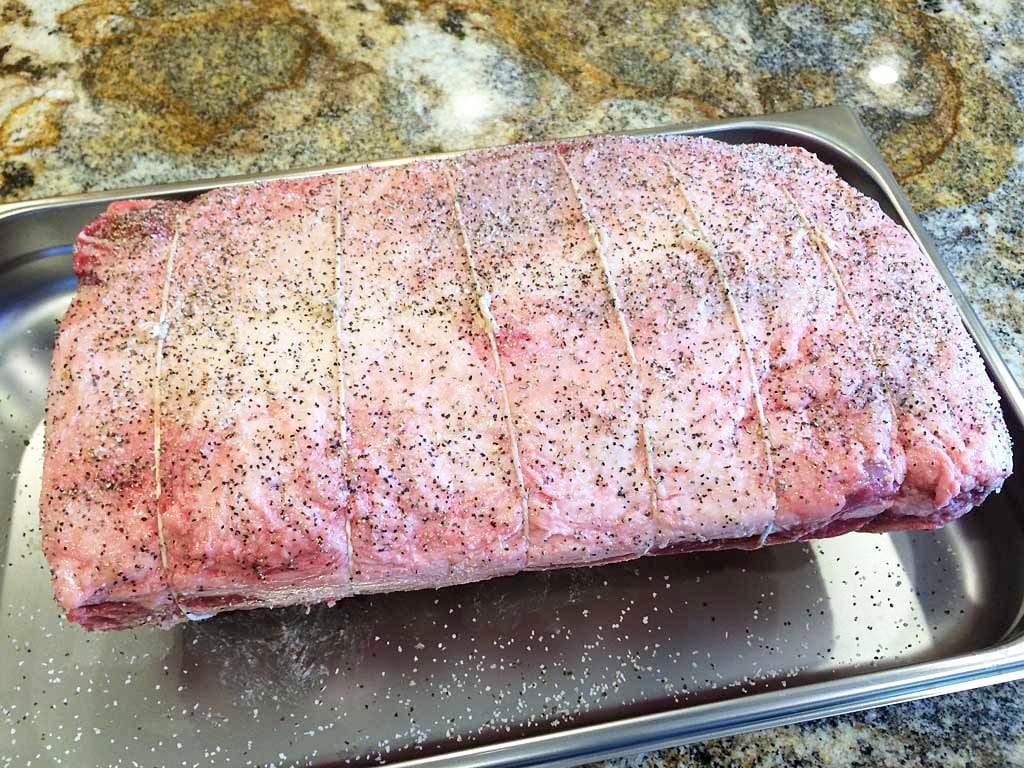 Standing rib roast is a great holiday treat that’s easy to prepare and will feed an army of hungry family and friends. Why not splurge and give it a try this year in your Weber Bullet? All you need to do it tie the meat, apply salt and pepper, and you’re ready to go.
Standing rib roast is a great holiday treat that’s easy to prepare and will feed an army of hungry family and friends. Why not splurge and give it a try this year in your Weber Bullet? All you need to do it tie the meat, apply salt and pepper, and you’re ready to go.
Here are some pictures I took when I prepared this roast on January 3, 2015. An earlier version of this article was published based on a roast I cooked on November 23, 2007.
Purchase & Prepare A Whole Standing Rib Roast
Most whole 7-bone standing rib roasts are too big to fit on the WSM 18.5″ cooking grate. When shopping for a roast, bring along a measuring tape and try to buy one that measures 17″ or less diagonally. Otherwise, you will have to cut off part of the roast. If you go this route, remove one bone’s worth of meat from the end with the shortest bones. This leaves the best meat intact as part of the larger roast. The removed portion can be cooked alongside the roast or saved for grilling another day.
This photo shows a 19.02 pound, USDA Choice, 7-bone whole standing rib roast bone-side up in Cryovac packaging.
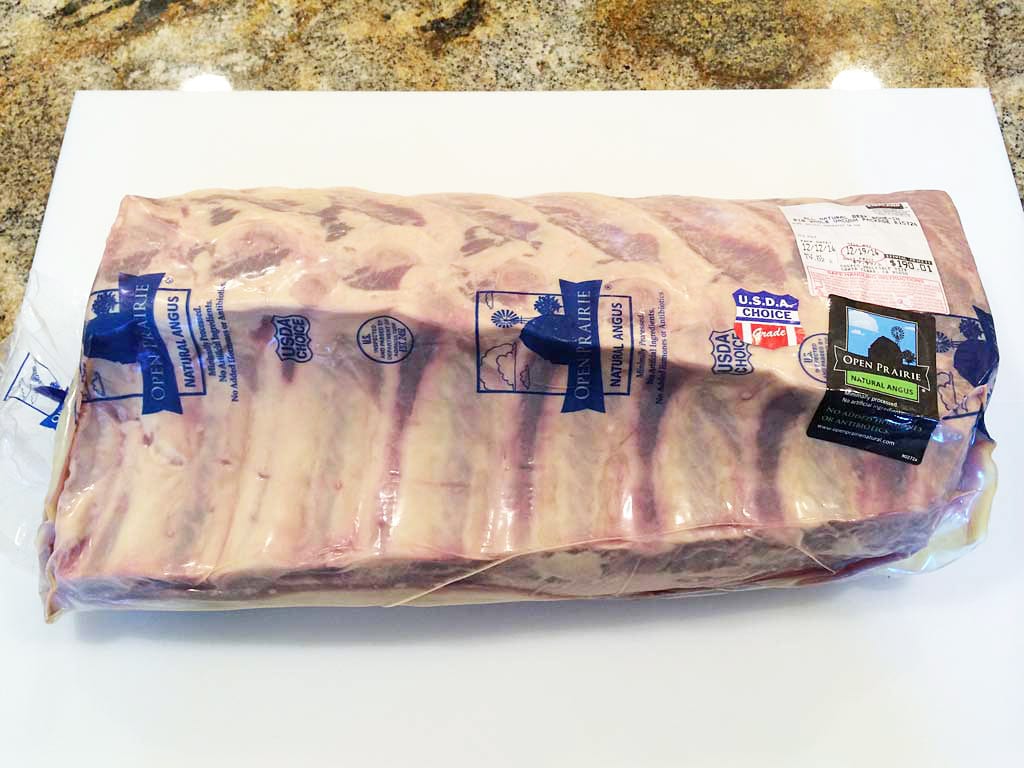
The whole roast was too large for the WSM, so I removed one bone’s worth of meat from the large end of the roast, as shown below.
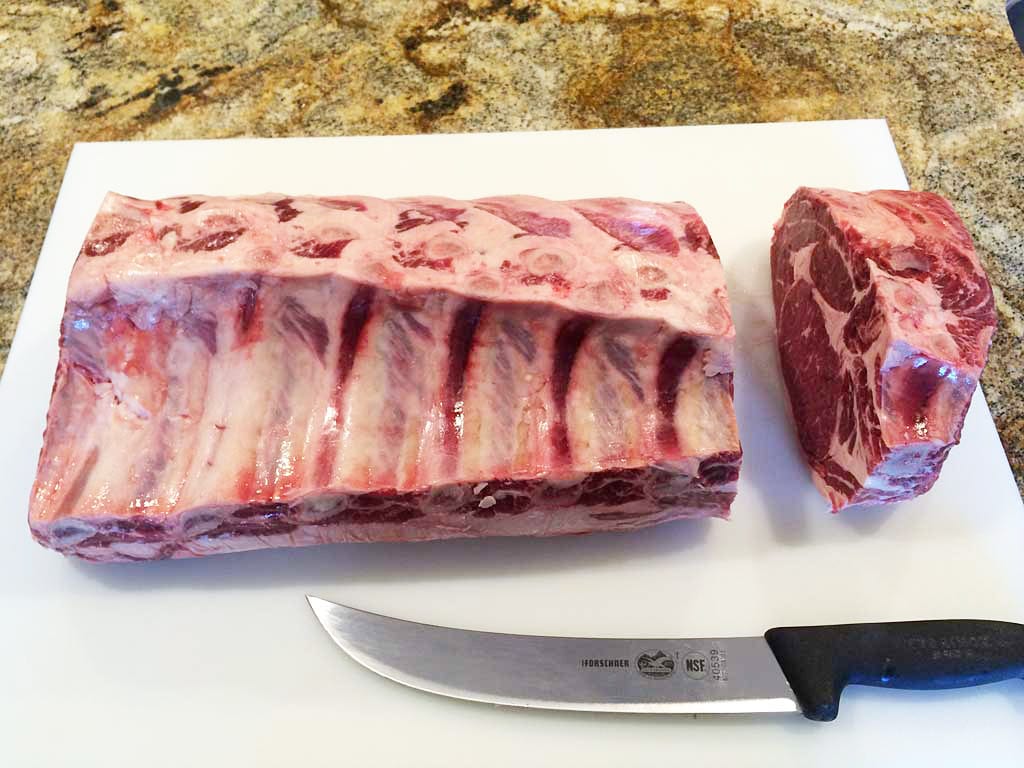
This photo shows what’s called the First Cut or Short End of the roast, which has more meat and less fat.
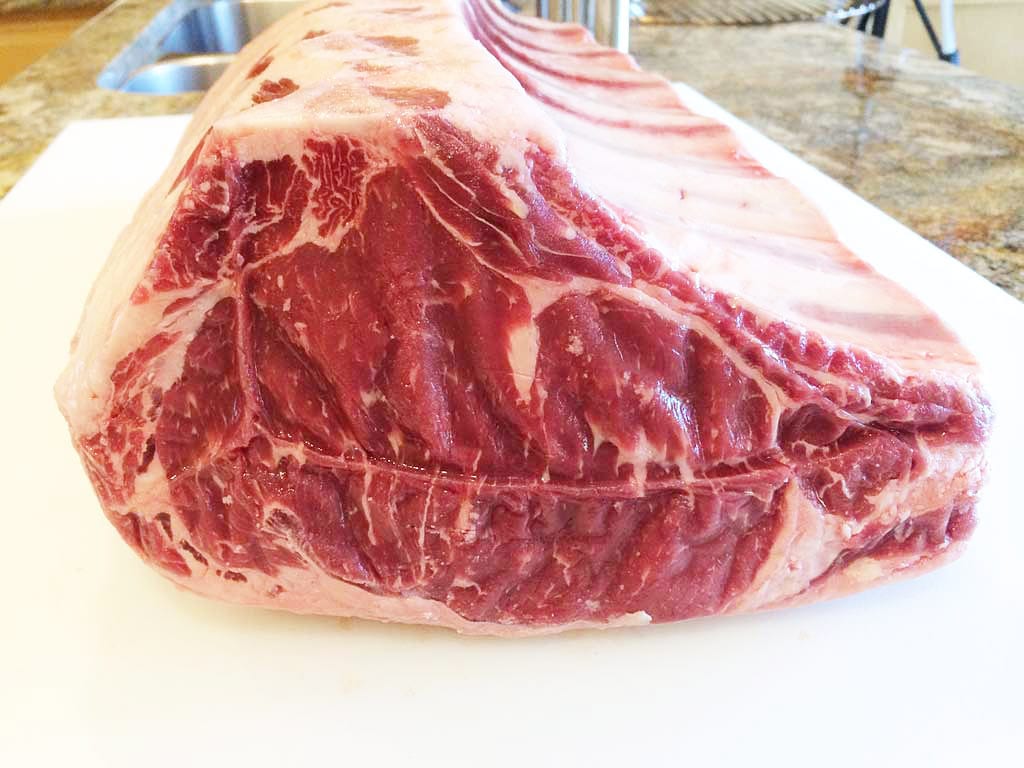
This photo shows what’s called the Long End of the roast, which has more areas of fat within the meat. This is the end from which I trimmed a piece to make the roast fit into the cooker.
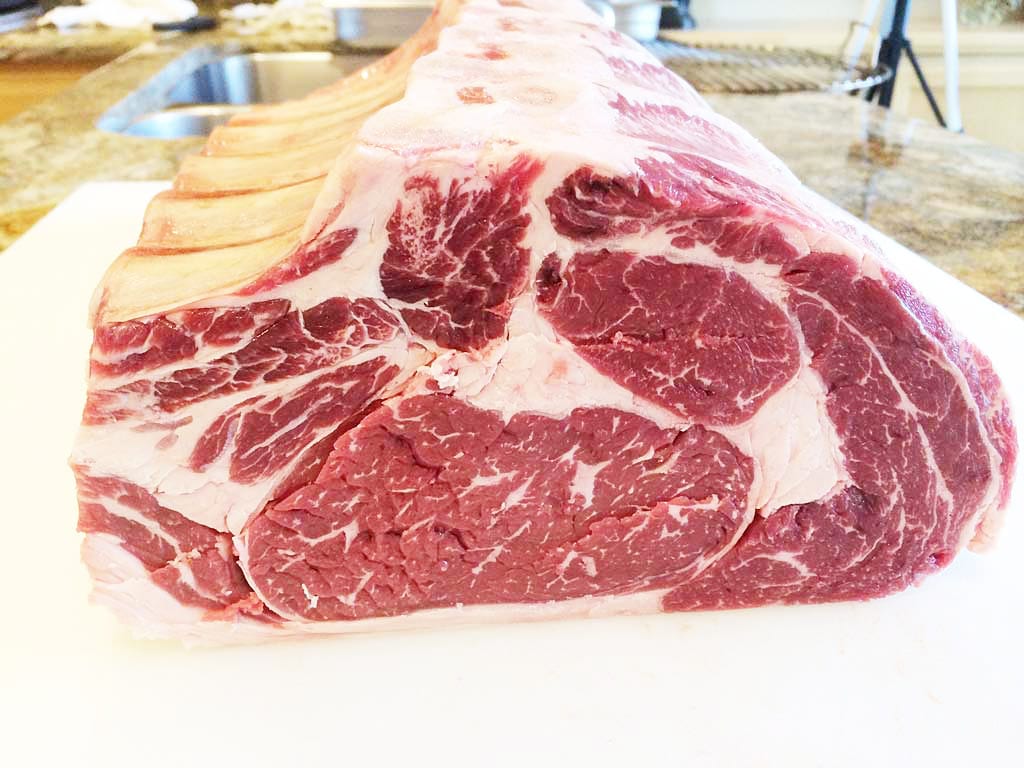
This photo shows the now 6-bone roast, weighing about 17.5 pounds, turned bone-side down and tied with kitchen twine at each bone.
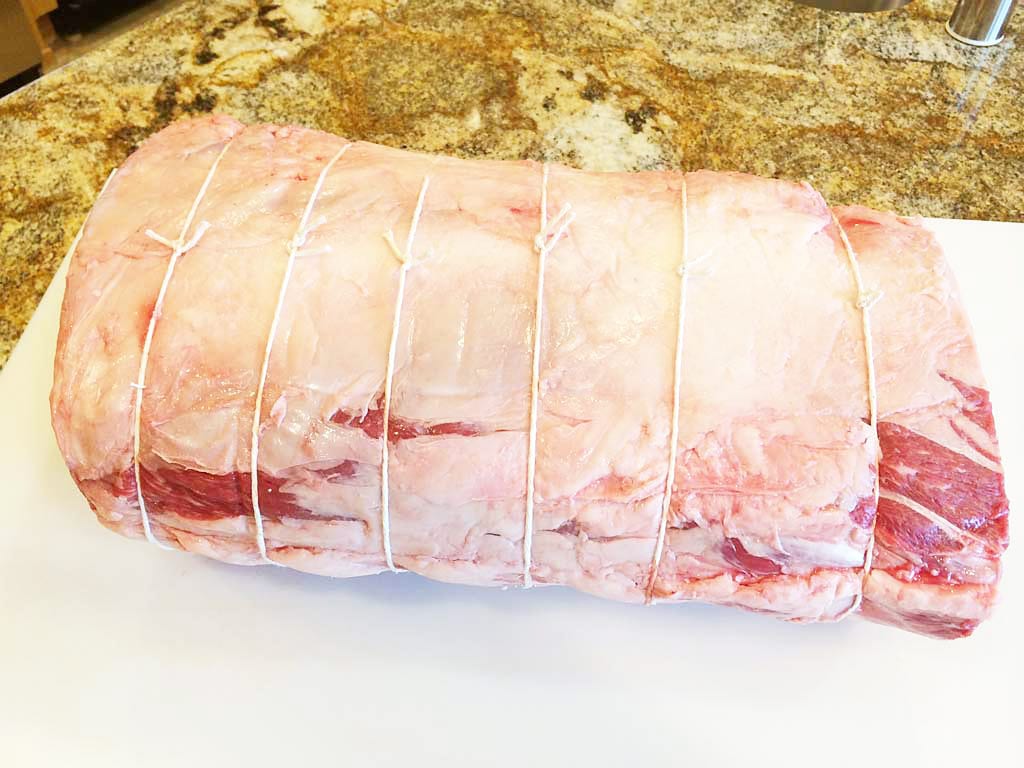
- When buying a bone-in rib roast, figure on 1 to 1-1/4 pounds pre-cooked weight per serving.
- Buy a roast with the rib bones attached. They provide better moisture retention and flavor, act as a natural roasting rack, and are good to eat.
- After trimming fat (optional), tie the roast at each bone. This prevents the spinalis dorsi muscle, also known as the “rib eye cap”, from separating from the outer edge of the roast during cooking. Tying also keeps the roast in a round shape for more even cooking. Place the roast bone-side down. Cut a length of kitchen twine, loop it around the roast parallel to the first bone, bringing the two ends to the top of the roast. Pull snug and tie with whatever kind of knot you like, then repeat at each bone.
- Don’t bother cutting the ribs off and tying them back on before cooking. They’re easily removed once the roast is cooked.
To learn more about standing rib roasts, see the Standing Rib Roast Selection & Preparation article.
This video demonstrates how to tie a roast. Click on the video to play.
Season The Roast
Standing rib roast is such a fine cut of meat that it needs nothing more than salt and pepper before cooking. Sometimes the simplest preparations are the most delicious.
Salt & Pepper Standing Rib Roast Seasoning
- 4 Tablespoons kosher salt
- 2 Tablespoons coarsely ground black pepper
Mix the ingredients thoroughly.
Pat the meat dry with paper towels. Brush all sides (except the bones) with a light coat of olive oil or vegetable oil, then sprinkle heavily with the salt/pepper mixture. Pat with your hands to help the cracked pepper adhere to the meat.
Cover loosely with plastic wrap and let sit at room temperature while you fire-up the cooker.
Select The Smoke Wood
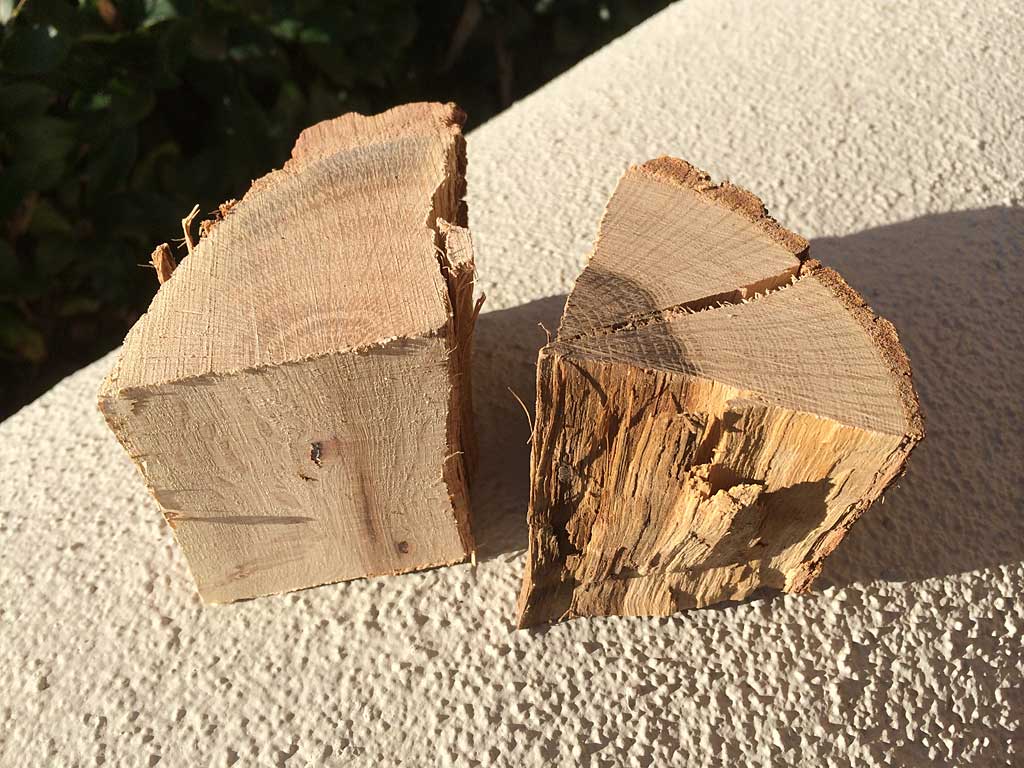
Use 2 chunks of dry oak wood. Each chunk should be about the size of your fist. Pecan, apple, or another mild fruit wood can be used if oak is not available.
There is no need to soak the wood or remove the bark before use.
Fire-Up The Cooker
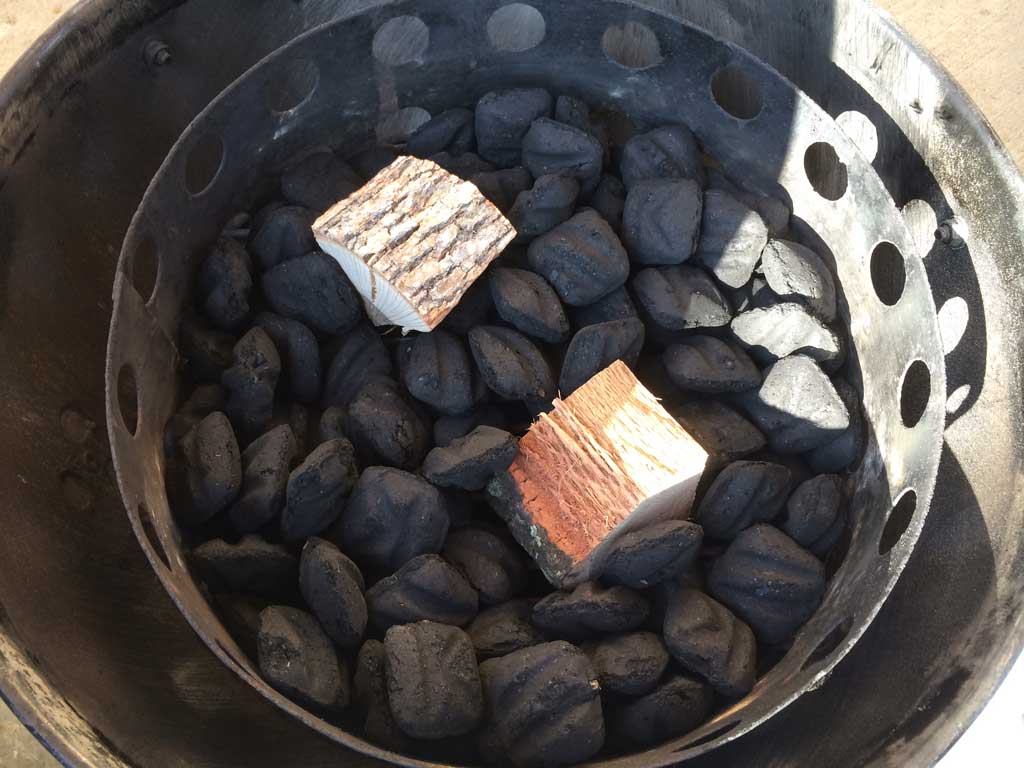
Cover the outside of the water pan with wide, heavy duty aluminum foil and place it in the middle cooking section.
Fire-up the cooker using the Minion Method. Place one full Weber chimney starter of unlit Kingsford Charcoal Briquets in the charcoal chamber. Place the smoke wood chunks on top of the unlit charcoal. Light 40 briquettes in a Weber chimney starter and spread them over the unlit briquettes and smoke wood chunks.
Insert the middle cooking section into the charcoal bowl and fill the water pan from above with hot tap water. Put the top cooking grate in place, then place the roast bone-side down on the grate.
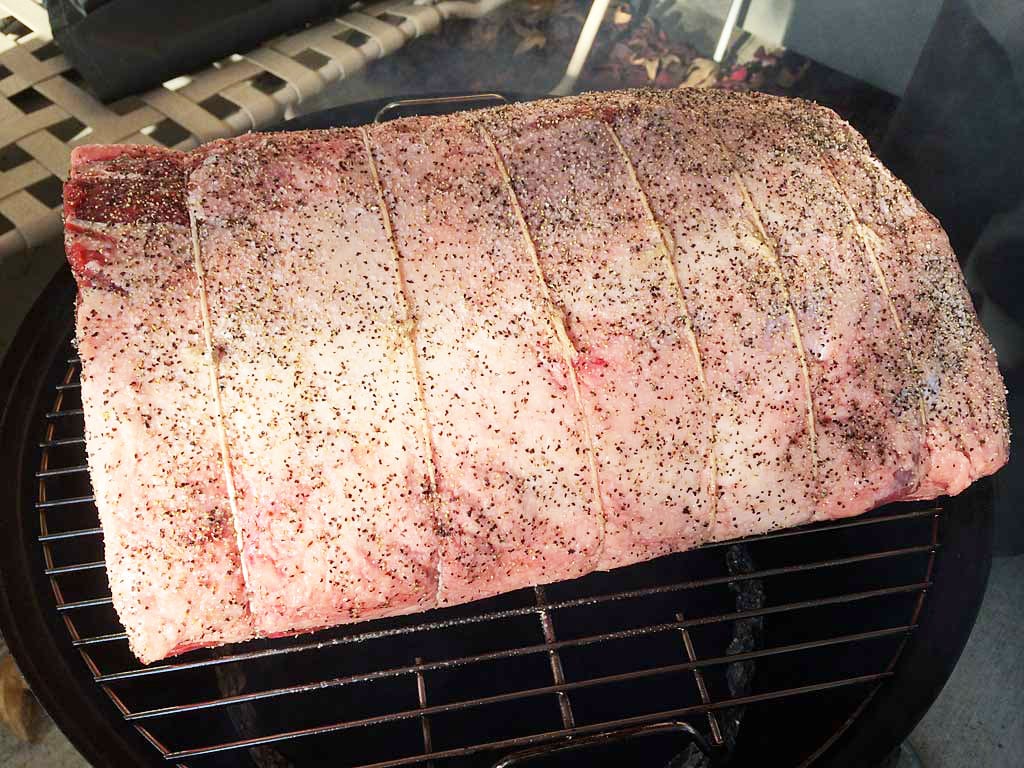
Insert a probe thermometer in the center of the roast to monitor the internal meat temperature during cooking. Place the lid on the cooker.
Smoke The Rib Roast, Then Sear In Oven
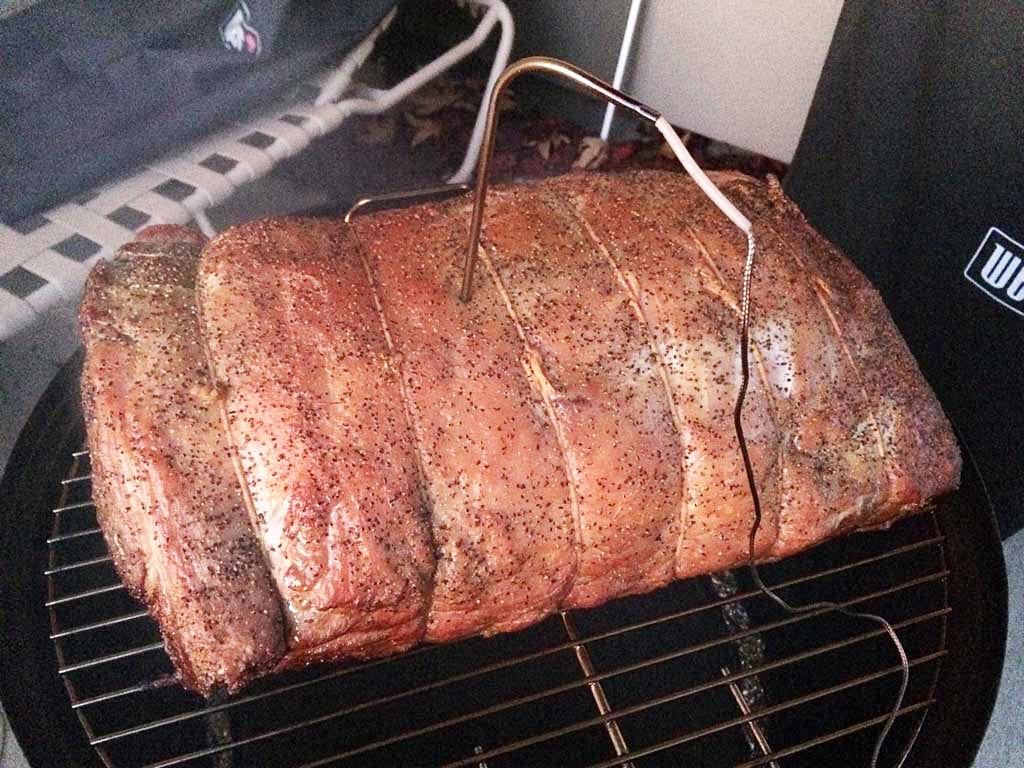 Set the top vent 100% open and leave it that way throughout the entire cooking session. Start with all three bottom vents 100% open. As the cooker approaches 200°F, begin to partially close all 3 bottom vents to maintain 225-250°F. Adjust the bottom vents as needed to maintain this temperature range throughout the cooking process.
Set the top vent 100% open and leave it that way throughout the entire cooking session. Start with all three bottom vents 100% open. As the cooker approaches 200°F, begin to partially close all 3 bottom vents to maintain 225-250°F. Adjust the bottom vents as needed to maintain this temperature range throughout the cooking process.
Cook the rib roast at 225-250°F until the internal meat temperature is 10°F below the final internal temp you want to achieve. See Standing Rib Roast Selection & Preparation for a chart of doneness internal temps.
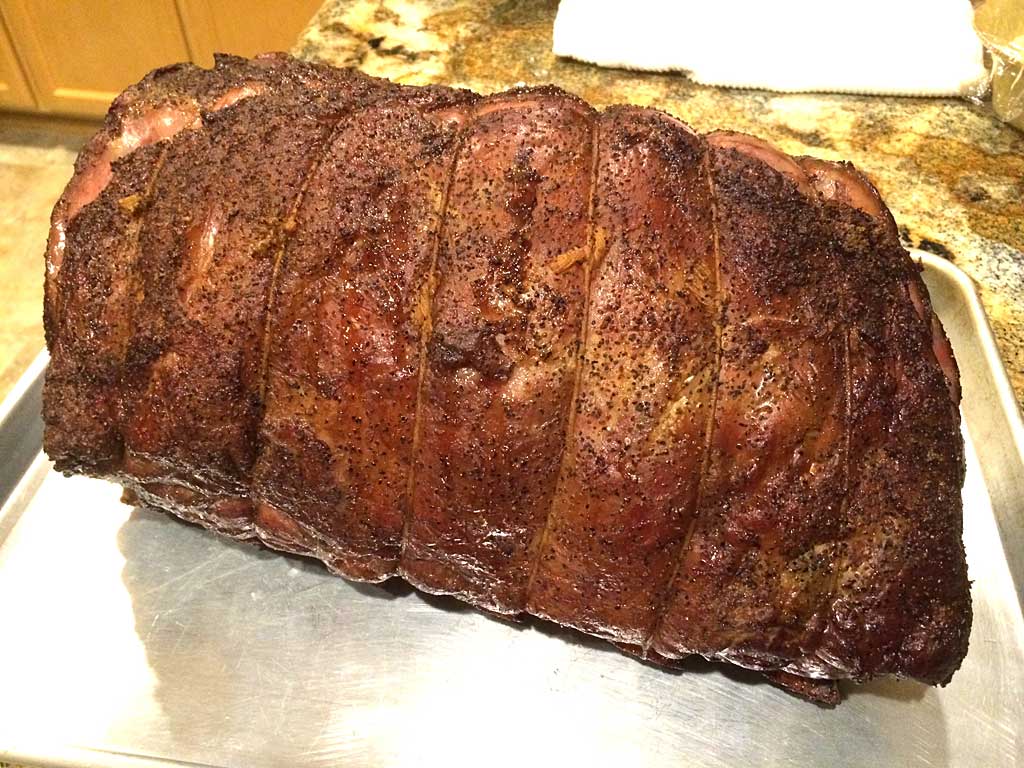
Move the roast to a rimmed baking sheet pan and place it in a preheated 500°F oven for 5 minutes to sear the exterior surface.
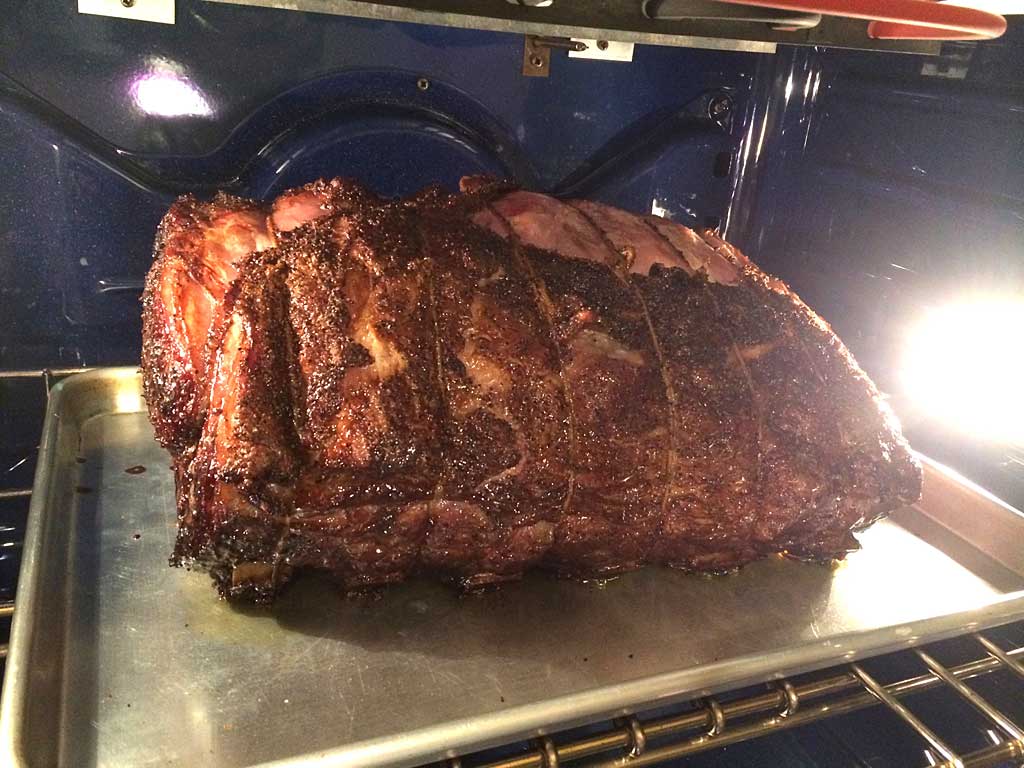 Remove the roast from the oven, cover loosely with aluminum foil, and let the meat rest for 15 minutes before serving.
Remove the roast from the oven, cover loosely with aluminum foil, and let the meat rest for 15 minutes before serving.
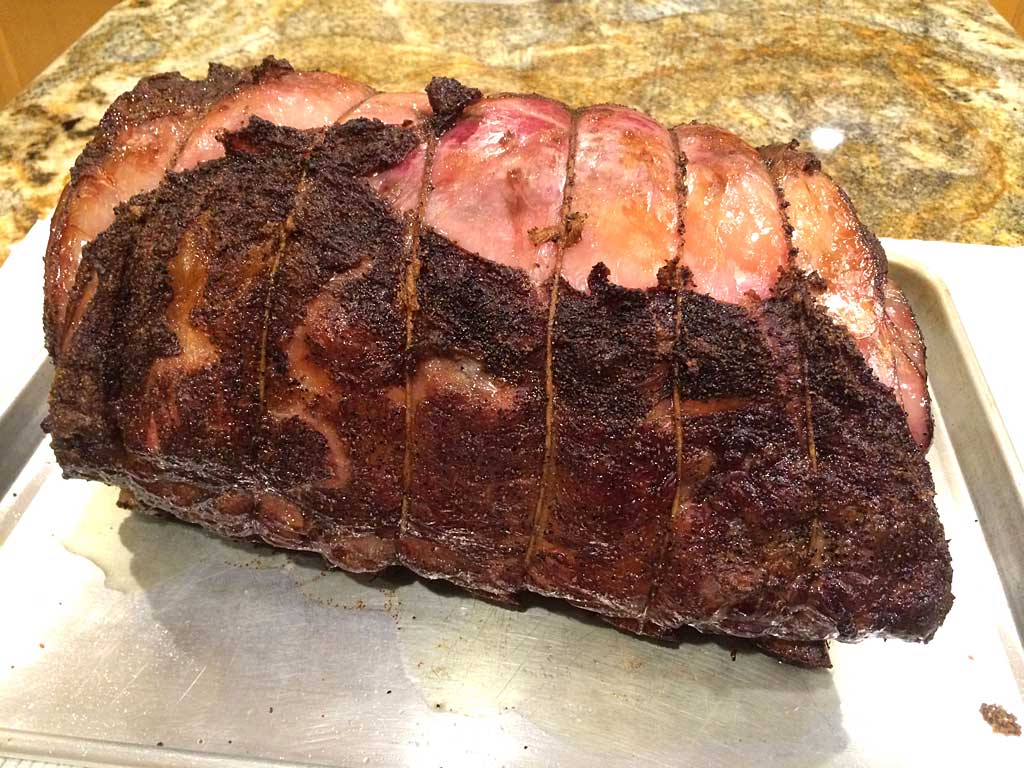
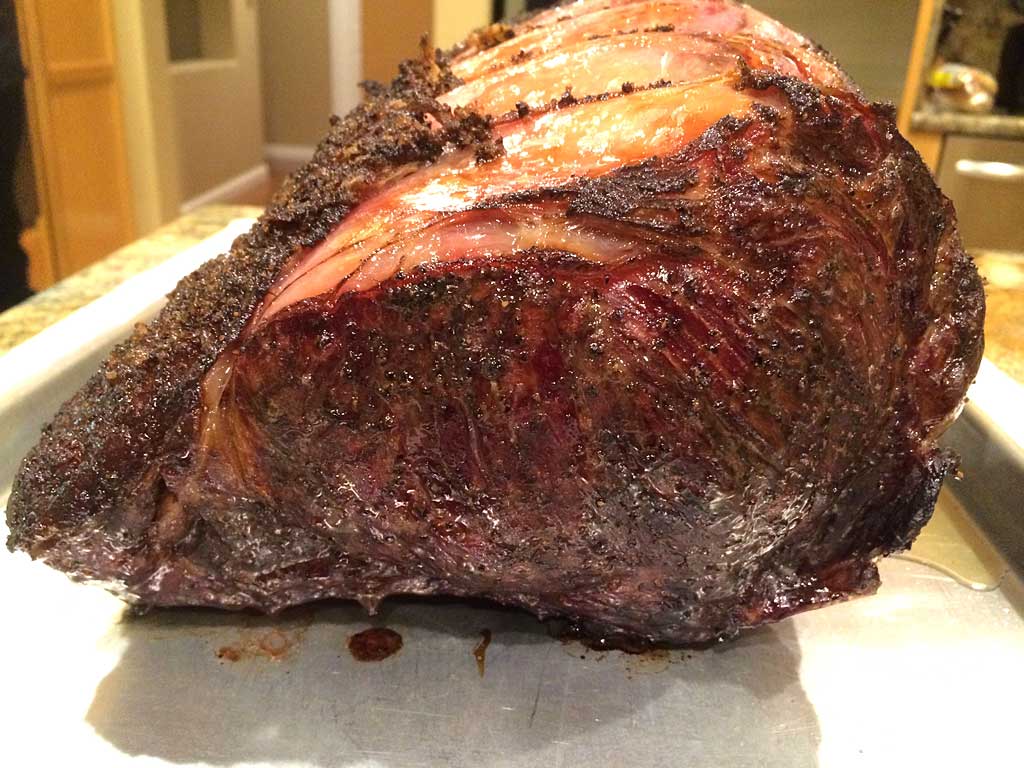
Residual heat in the meat will cause the internal temp to rise 5-10°F during the rest and the juices will redistribute and stabilize within the roast.
Alternatively, after searing you can hold the roast at serving temperature for up to an hour by wrapping it tightly with two layers of foil and placing it in an empty cooler.
For this roast, I cooked the meat to an internal temp of 125°F for medium rare, then seared it for 5 minutes and rested it for 15 minutes before serving.
There’s no need to baste or turn the meat during cooking.
Estimated cooking time for a whole rib roast is 10-15 minutes per pound (this roast took about 15 minutes per pound).
Here’s how the cooker and internal meat temperatures went during the cooking process.
| Time | Lid Temp | Meat Temp | Vent 1 % | Vent 2 % | Vent 3 % |
| 3:00 pm | – | – | 100 | 100 | 100 |
| 3:15 pm | 240 | – | 50 | 50 | 0 |
| 3:30 pm | 235 | – | 50 | 50 | 0 |
| 3:45 pm | 250 | – | 50 | 0 | 0 |
| 4:00 pm | 240 | 35 | 50 | 0 | 0 |
| 4:15 pm | 240 | – | 50 | 0 | 0 |
| 4:30 pm | 240 | 44 | 50 | 0 | 0 |
| 4:45pm | 243 | 71 | 50 | 0 | 0 |
| 5:00 pm | 237 | 77 | 50 | 0 | 0 |
| 5:15 pm | 225 | 82 | 50 | 50 | 0 |
| 5:30 pm | 225 | 87 | 50 | 50 | 50 |
| 5:45 pm | 225 | 93 | 100 | 50 | 50 |
| 6:00 pm | 245 | 100 | 50 | 50 | 50 |
| 6:15 pm | 249 | 105 | 50 | 50 | 50 |
| 6:30 pm | 258 | 109 | 50 | 50 | 0 |
| 6:45 pm | 254 | 114 | 50 | 0 | 0 |
| 7:00 pm | 229 | 118 | 50 | 0 | 0 |
| 7:15 pm | 235 | 122 | 50 | 0 | 0 |
| 7:25 pm | 235 | 125 | 50 | 0 | 0 |
Note that the vent percentages represent the way I set the vents at the time indicated.
Carve & Serve The Roast
For easier handling, divide the roast into two halves by cutting between bones 3 and 4.
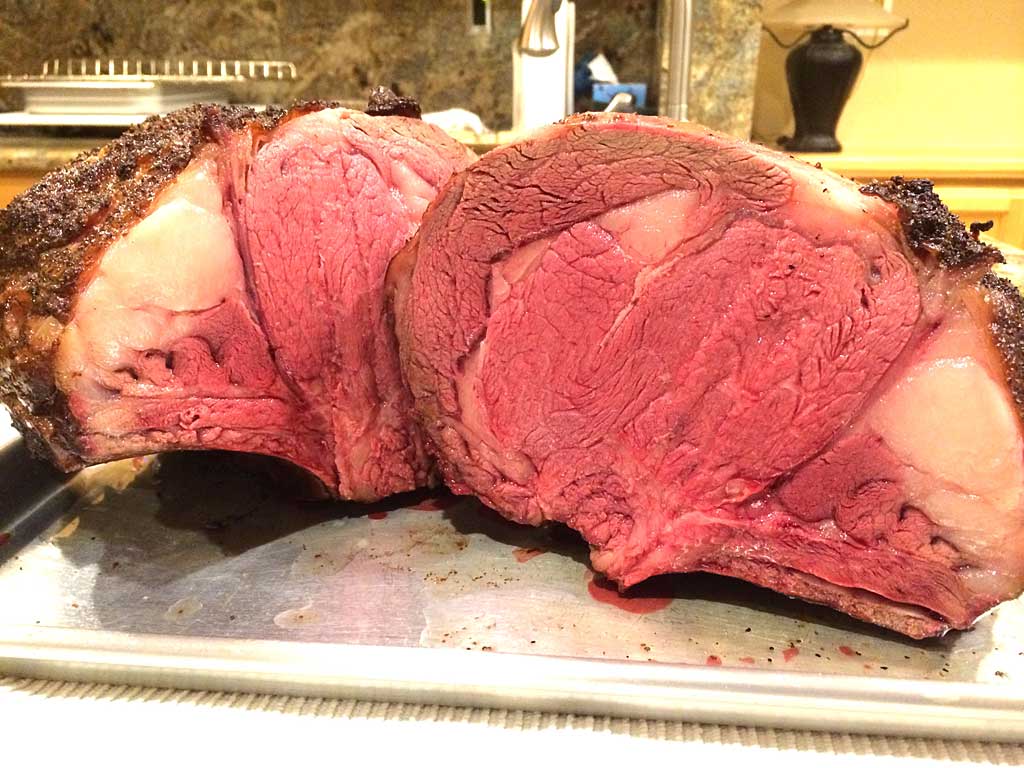
To carve, remove the twine and roll the roast onto its side so the bones are pointing straight up. Using the bones as a handle, cut downward close to the bones using a sharp boning knife or an electric carving knife to remove the bones. Click here to see the cutting process as a GIF.
Next, place the roast flat on the cutting board and carve slices 1/2″ thick or to your liking. Cut the bones into individual pieces and serve them along with the roast…or save them for yourself!
This photo shows the medium rare interior after resting for 15 minutes.
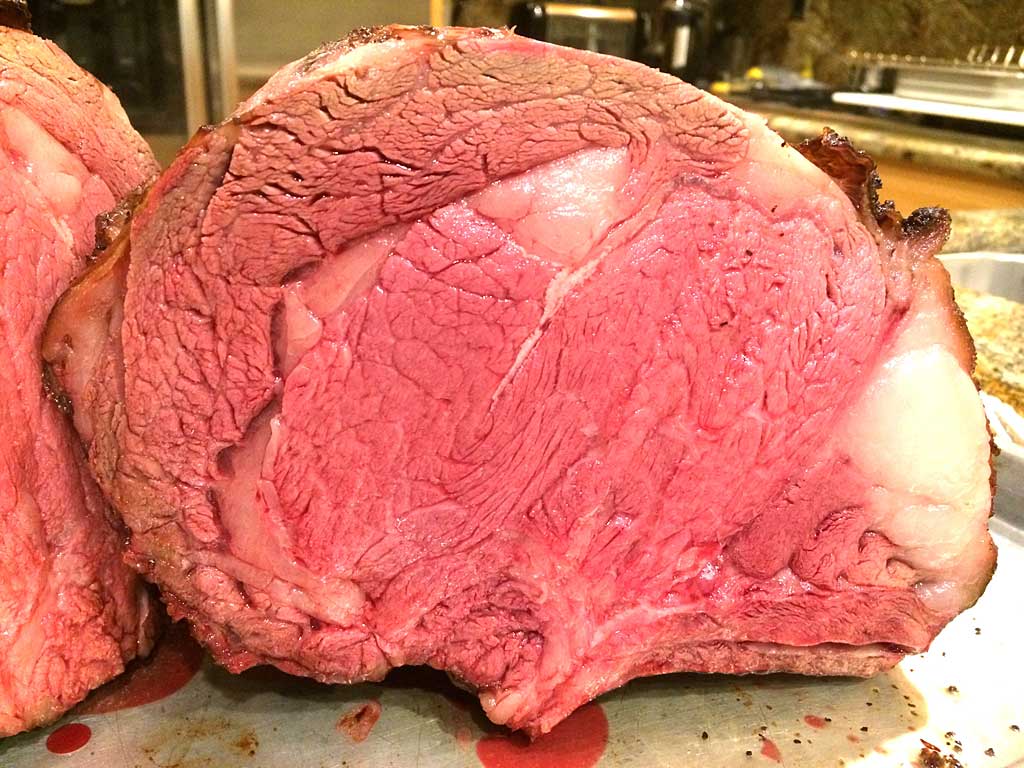 This photo shows a slice of rib roast served with creamy horseradish and au jus.
This photo shows a slice of rib roast served with creamy horseradish and au jus.
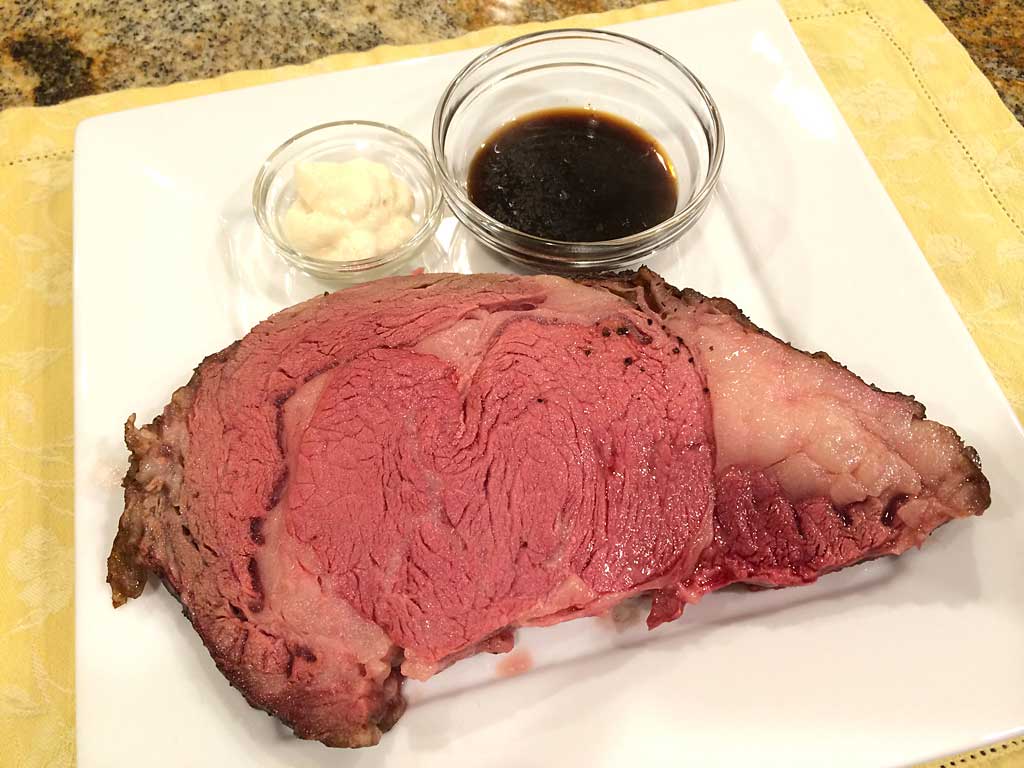 These photos show a bowl of sliced rib bones and rib bones served with rice and green beans.
These photos show a bowl of sliced rib bones and rib bones served with rice and green beans.
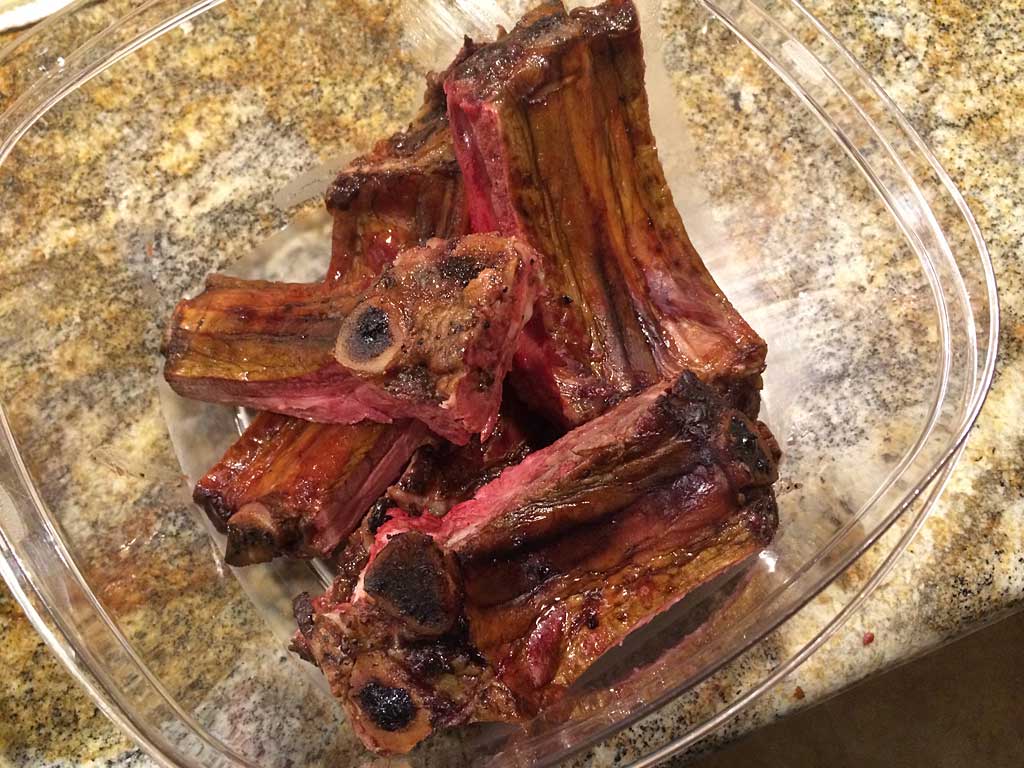
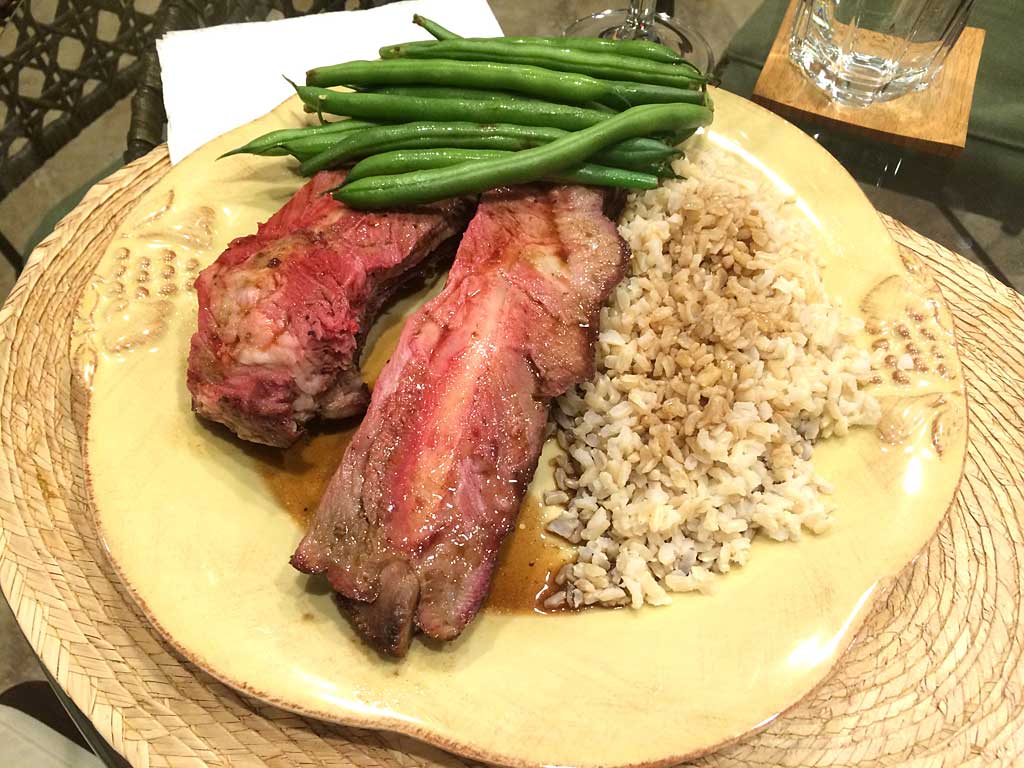
This roast was very well seasoned and intensely flavored. The oak wood provided just the right amount of smoky goodness and the slightest smoke ring. Of course, the meat was very tender and juicy.
You’ll notice in the photos above that the roast had a dark, crusty exterior layer that looked great before searing, but the exterior cracked and shrank during the 5 minute oven sear. This doesn’t matter once the meat is sliced and served, but if you’re concerned about looks, you might consider skipping the sear step to avoid the possibility of exterior cracking and shrinkage.
Portion and Freeze Leftovers
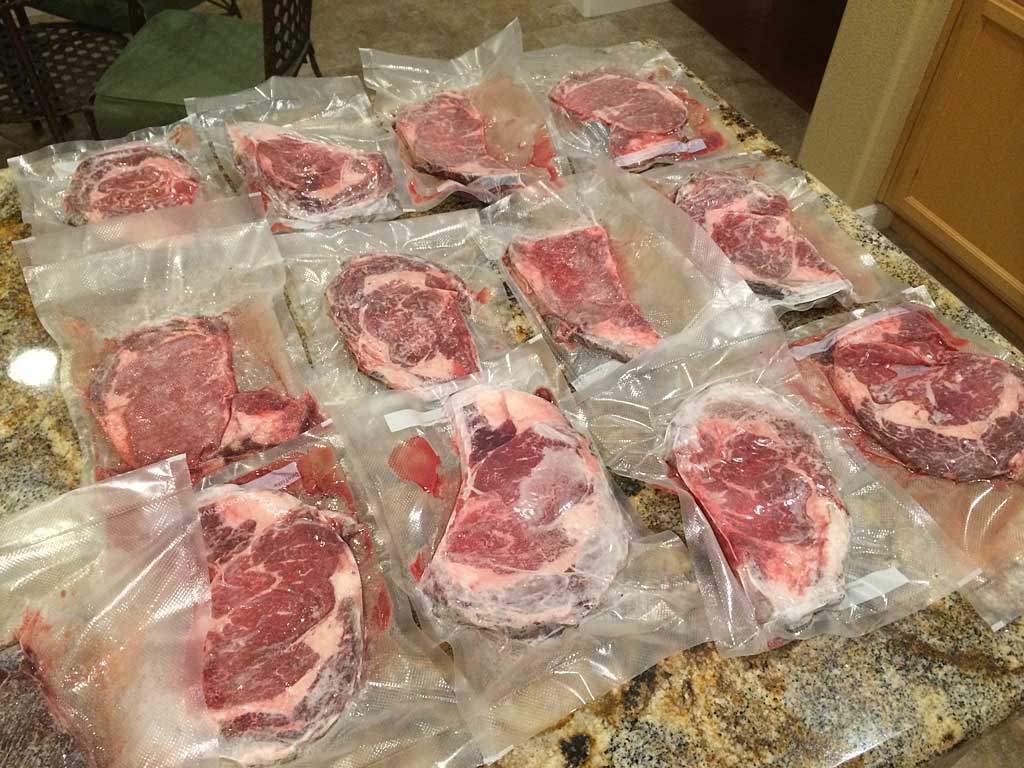 Even if you’re serving a whole standing rib roast to a big group of family and friends, you’re likely to end up with leftovers. I like to slice the leftover roast into serving portions and vacuum pack each portion in FoodSaver bags. These can be frozen for months then thawed and reheated gently in boiling water right in the bag, or at 20% power in the microwave on a plate covered with plastic wrap. It tastes almost as good as the day you originally cooked it.
Even if you’re serving a whole standing rib roast to a big group of family and friends, you’re likely to end up with leftovers. I like to slice the leftover roast into serving portions and vacuum pack each portion in FoodSaver bags. These can be frozen for months then thawed and reheated gently in boiling water right in the bag, or at 20% power in the microwave on a plate covered with plastic wrap. It tastes almost as good as the day you originally cooked it.
This photo shows leftover rib roast, sliced thin and served on a toasted sandwich roll with garlic butter, creamy horseradish and au jus.
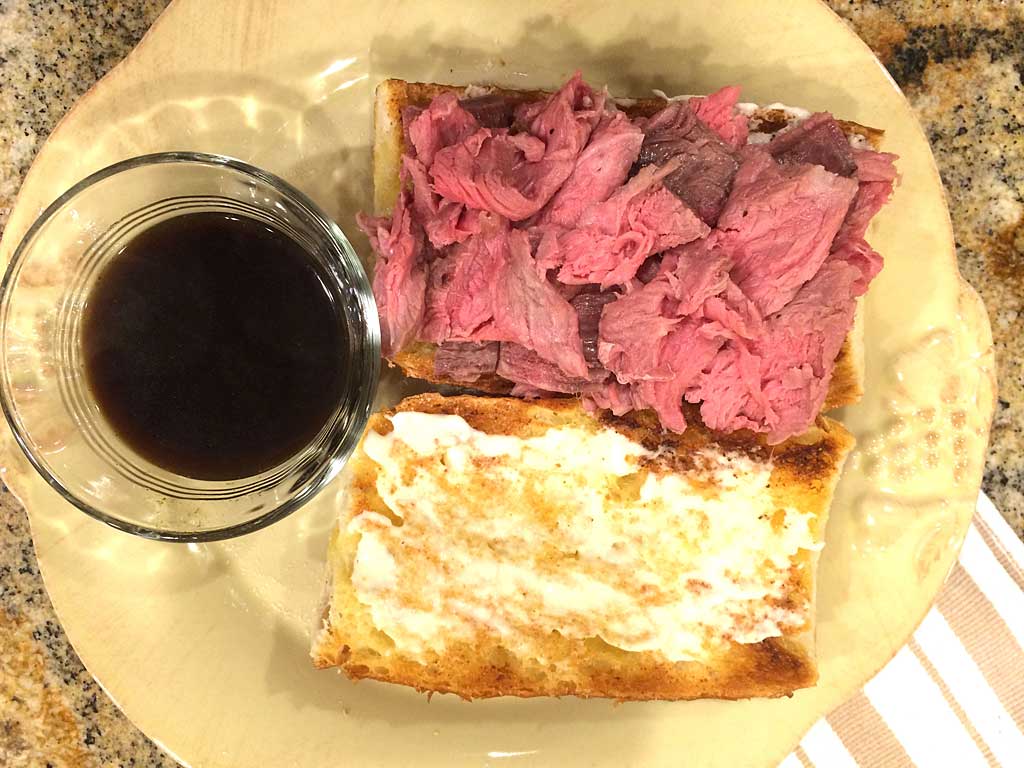
Bonus: Horseradish Cream Sauce
If you want to use a commercial horseradish sauce, I like Beaver Brand Cream Horseradish Sauce. If you want to make your own, here’s an easy horseradish sauce to serve with this standing rib roast.
Horseradish Cream Sauce
From Cook’s Illustrated magazine
- 1/2 cup heavy cream
- 1/2 cup prepared horseradish
- 1 teaspoon table salt
- 1/8 teaspoon ground black pepper
Whisk the heavy cream for 1-2 minutes until thickened but not yet holding soft peaks. Fold in horseradish, salt, and pepper. Transfer to a serving bowl and refrigerate 30-60 minutes before serving.

